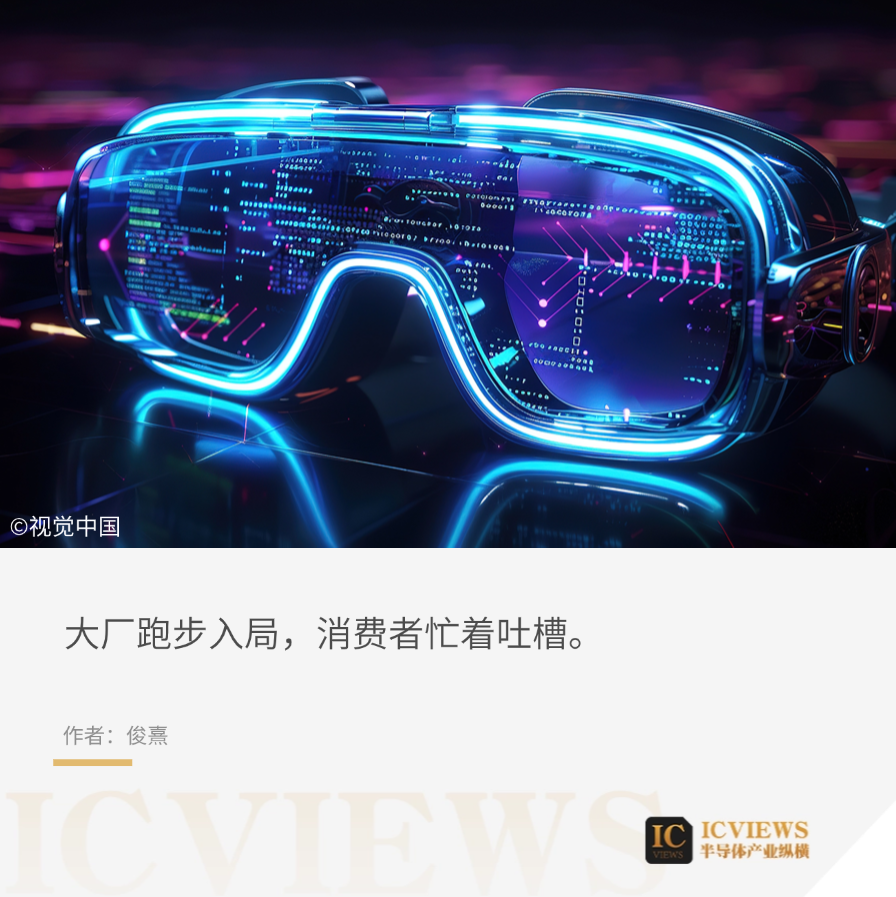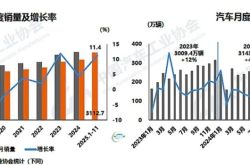AI Glasses: Are They Finally Poised for Success?
![]() 08/28 2025
08/28 2025
![]() 558
558

2025 has been hailed as the inaugural year for AI glasses.
According to IDC's "Quarterly Tracking Report on the Global Smart Glasses Market," global and Chinese smart glasses shipments in Q1 2025 reached 1.487 million and 494,000 units respectively, marking year-on-year growth of 82.3% and 116.1%.
IDC forecasts that global shipments will surge to 14.518 million units by the end of 2025, with the Chinese market expected to hit 2.907 million units, representing year-on-year growth of 42.5% and 121.1% respectively.
Recently, the AI smart glasses market has witnessed a flurry of excitement, with industry giants such as Xiaomi, Alibaba, 360, China Telecom, and Lixiang entering the fray. Consumer enthusiasm has also gradually intensified. According to Tmall statistics, search volumes related to smart AR glasses soared by 78% year-on-year within a week. On content creation platforms like Xiaohongshu and Bilibili, AI glasses-related reviews are rapidly on the rise.
However, this surge in popularity has been accompanied by a significant number of complaints. AI glasses have been the subject of ongoing controversy regarding quality, functionality, and pricing, with many early adopters providing negative feedback.
So, will AI glasses finally succeed this time around and emerge as the "entry point for the next generation of computing platforms"? And if they do, what opportunities will they bring to the industry chain?
01 Big Players Are Rushing In
As June rolled in, industry heavyweights could no longer contain their enthusiasm.
On June 26, Xiaomi officially unveiled its first AI glasses with a starting price of 1999 yuan. Positioned as "personal smart devices for the next generation" and "portable AI entry points," these glasses are equipped with the Qualcomm Snapdragon AR1 chip, enabling functions such as photo and video recording, Q&A, translation, headset capabilities, and payments.
According to official JD.com data, Xiaomi AI glasses sold over 10,000 units within 12 hours of their launch, topping the sales chart for smart glasses categories. Xiaomi Homes also saw a surge in visitors, with stocks quickly selling out in many stores.
On July 26, at the 2025 World Artificial Intelligence Conference (WAIC), Alibaba announced the technological advancements of its Kuake AI glasses. Kuake AI glasses offer two versions: AI glasses without display functionality and AI+AR smart glasses with display functionality. The version with display functionality takes precedence and is expected to adopt a dual-chip architecture, equipped with both the Qualcomm Snapdragon AR1 and Besound BES2800 chips.
Kuake AI glasses will deeply integrate the Alibaba and Alipay ecosystems, featuring Tongyi Qianwen's large model and Kuake's latest AI capabilities. It also supports Gaode navigation, Alipay's Look and Pay, Taobao's Photo Search, and Fliggy's travel itinerary reminders. Industry insiders note that the primary distinction between Kuake AI glasses and existing market products lies in their deep integration with the Alibaba ecosystem.
Similarly, at the 2025 WAIC, China Telecom's Tianyi AI unveiled its first wearable device, the Tianyi AI smart glasses, priced at 1999 yuan. Equipped with the Qualcomm Snapdragon AR1 chip, it features a 2GB+32GB storage combination, a 12-megapixel ultra-wide-angle lens, supports 1440P 30fps video recording, and boasts professional imaging technologies such as EIS electronic image stabilization, LDC distortion correction, and HDR. It offers a single charge battery life of 7 hours for audio playback, 200 minutes for Bluetooth playback, and 35 minutes for video recording.
It's worth mentioning that China Telecom isn't the only telecommunications operator deploying AI glasses. All three major domestic operators have made moves in this field: in Q1 2025, China Mobile planned to launch three premium AI glasses and announced that it would introduce over ten products across four series in the future; China Unicom launched eSIM AI sports glasses in collaboration with Singularity Horizon last year.
On August 14, HTC released its first AI smart glasses, VIVE Eagle, priced at NT$15,600 (approximately RMB 3,739). Equipped with the Qualcomm Snapdragon AR1 Gen 1 chip, it features 4GB+32GB storage, a 12MP ultra-wide-angle camera, dual open-type bass-enhanced stereo speakers, and a 4-array microphone system, connecting via Wi-Fi 6E or Bluetooth 5.3. The product has a built-in 235mAh battery, offering over 36 hours of standby time on a single full charge, up to 4.5 hours of continuous music playback, and over 3 hours of continuous call time.
In addition, during the recently held 2025 China Internet Conference, Zhou Hongyi, founder of the 360 Group, revealed in an interview with the media that 360 would soon release two AI smart hardware products: an AI smart recorder and AI smart glasses.
There are also reports that Lixiang Auto's first AI smart glasses for photography may debut with a solution featuring Besound BES 2800+ Research Micro ISP. This AI glasses is a joint development between Lixiang and GoerTek, with GoerTek responsible for the hardware and Lixiang for the software. The product will be integrated with the Mind GPT large model and Alipay's Look and Pay functionality.
02 The "Underwater Battle" of the Supply Chain
Xu Chi, founder and CEO of XREAL, stated that the "hundred glasses battle" in the AI glasses market is akin to an "underwater battle." Winning this battle hinges on solving core technological issues, including chips, optical waveguides, and AI.
Among these, hardware serves as the foundation of AI glasses performance and a significant cost driver.
AI glasses chips account for 30% to 40% of the total product cost and represent the performance core of the product. The SoC chip integrates CPU, GPU, and NPU units, determining the device's computing, AI processing, and imaging capabilities.
Currently, there are three mainstream solutions: the first is the system-level SoC solution, represented by Qualcomm AR1, known for its high integration and powerful computing power. While it supports complex AI functions, it also incurs the highest cost and power consumption, making it mostly used in flagship products;
The second is the MCU-level SoC + external ISP solution, characterized by extremely low cost and power consumption but limited performance, making it challenging to support complex AI models and suitable for entry-level products;
The third is the SoC+MCU dual-core architecture, which strikes a balance between performance and battery life by allowing the SoC to handle high-load tasks and the MCU to manage low-power scenarios, with moderate costs.
As AI functions deepen, the industry generally faces the core contradiction between surging computing power demand and power consumption and battery life limitations. To address this challenge, the industry is approaching it from multiple angles: on one hand, adopting more advanced process technologies such as 6nm and 4nm to enhance chip energy efficiency; on the other hand, utilizing technologies such as Dynamic Voltage and Frequency Scaling (DVFS) and heterogeneous division of labor between big and small cores to dynamically manage power consumption based on real-time load.
In the future, 3D stacked packaging realized through TSV (Through-Silicon Via) technology is expected to integrate computing and storage units in the vertical dimension, further breaking through performance and power consumption bottlenecks, providing critical support for AI glasses to achieve stronger functions and longer battery life.
The visual functionality of AI glasses is realized by CMOS image sensors, and their performance underpins imaging quality and visual interaction capabilities.
The current market is predominantly dominated by Sony's IMX681. Adopted by most mainstream products such as ThunderBird and Meta, this model is favored due to its compact size, low power consumption, global shutter technology that avoids motion picture distortion, and high compatibility with the mainstream Qualcomm AR1 computing platform, constituting a mature imaging solution that shortens product development cycles.
However, as the market places higher demands on imaging quality and battery life, the original single supply pattern is beginning to shift. Chinese vendors, represented by Omnivision and SmartSens, are entering the market with their products' cost-effectiveness and customization capabilities.
Omnivision has secured a spot in Amazon's AI glasses project supply chain, while SmartSens released the 12-megapixel sensor SC1200IOT for AI glasses in May 2025. This sensor features a small package size, optimized power consumption, and improved sensitivity compared to products of the same specification, with plans for mass production in the second quarter of the same year.
Due to the complexity of AI glasses, which involve precision optics, sensors, chip modules, and other components, OEM/ODM manufacturers have become pivotal for brands to swiftly enter the market with their mature manufacturing processes and flexible supply chains.
After integrating Wintech's ODM assets, Luxshare Precision now provides augmented reality (AR) glasses manufacturing and consumer electronics component assembly services for brands such as Meizu and Oppo.
Another leading smart hardware ODM manufacturer, Huqin Technology, has established partnerships in multiple fields through early collaborations with chip giants such as MediaTek, Qualcomm, Huawei, Xiaomi, and OPPO.
Furthermore, E-Dao Information is collaborating with Rokid and Huawei to provide rapid customization and module development capabilities and holds Microsoft's hardware OEM qualification. Skyworth has entered the AR glasses + Huawei ecosystem, collaborating with Pico under ByteDance, targeting consumer entertainment and social scenarios.
Other vendors such as Essilor, Nanke, Cosonic, and AAC Electronics have also swiftly adjusted their production lines to invest in the development of AI glasses micro-modules, optical lenses, and acoustic components.
Industry insiders point out that the structural similarity between the AI glasses industry and smart wearable devices enables existing wearable device OEM manufacturers to take the lead in seamlessly transforming into pioneers in this emerging market.
Given the miniaturization, multi-module integration, and all-day wear characteristics of AI glasses, PCBs face new structural challenges, with designs moving towards high density, multi-layer, flexibility, and high bend resistance. This presents new opportunities for transformation and upgrading for Chinese PCB manufacturers, with flexible printed circuit boards (FPC) expected to become a new growth point in the consumer electronics sector.
The disruptive aspect of AI glasses lies in integrating environmental perception systems and navigation functions into narrow bezels and temple arms, achieving a lightweight design (only 50 grams per pair), suitable for all-day wear. This amounts to an FPC revolution within millimeter-level space.
The length and area of flexible circuit boards required for each pair of glasses reach three times that of traditional smartphones, carrying over 20 sensor signal transmission and power management tasks.
Moreover, the custom-designed FPC neural network must withstand over 100,000 bending cycles while maintaining zero signal attenuation at 5G frequencies, which will drive the development of FPC towards the combination of miniaturization and ultra-high-frequency computing.
03 Don't Rush to Celebrate
It's still premature to conclude that "AI glasses will be the next trend." Amidst the heated atmosphere, some data reflect a sobering reality.
According to Chanmama data, Xiaomi AI glasses sales on Douyin's flagship store exhibited a high opening but low closing trend. Sales peaked on the first day of launch with daily sales of 5,000-7,500 units but subsequently declined, falling to 100-250 units per day as of August 18.
According to industry media VR Vision statistics, the average return rate for AI glasses on the Douyin platform is 40%-50%, with Xiaomi not spared, experiencing a return rate of about 40% on the platform.
Reasons for returns include but are not limited to files not displaying normally on the App after shooting, slow voice recognition and photo response leading to an interactive experience falling short of the demo level at the launch event, insufficient battery life that doesn't last a day with heavy use, inconsistent with the expectation of "all-day wear."
It's not just Xiaomi; currently, almost all photography-oriented AI glasses suffer from poor user experience. Products like ThunderBird V3 and Rokid Glasses have also faced heavy criticism from netizens on social media. Negative feedback primarily focuses on short battery life, poor interactive experience, and low photo quality.
Even more so, some users have expressed after experiencing the products that it's still too early to invest in AI glasses, warning of potential "early adopter pitfalls."
The AI glasses sector has attracted significant attention several times in the past but eventually faded away. In 2012, Google released Project Glass, a futuristic glasses concept design featuring a display and camera, running on the Android system, and providing functions such as navigation and photography, considered the dawn of wearable smart devices.
At the time, Google heralded it as a "moonshot project," stating that the product would revolutionize the way humans interact with the world. However, by 2015, due to issues such as insufficient battery life, high cost, and discomfort during wear, Google announced the cessation of Explorer sales, and the consumer-facing Google Glass project was officially shelved.
In 2015, Microsoft released the highly sci-fi headset Hololens but also failed to survive past the second generation due to similar issues.
And to this day, the same problems continue to plague AI glasses manufacturers.
04 Conclusion
Overall, for AI glasses to truly take off, they still need to overcome the immaturity of both the hardware supply chain and AI technology.
According to iResearch survey findings, consumer feedback on AI hardware highlights three primary concerns: exorbitant prices, the need for enhanced software and hardware efficiency, and data privacy and security. Among interested customers, AI interactive functions, real-time translation, and photography/videography capabilities are the most sought-after features, with a preference for convenience and integrated functionality reflecting users' desire for all-in-one solutions.
Manufacturers of AI glasses must collaborate effectively with upstream hardware suppliers to foster industrial ecological synergy. Additionally, they must determine the "killer application" for AI glasses and devise strategies to create a competitive advantage through AI applications.
Even the application logic for AI glasses merits reconsideration. Some experts argue that AI glasses are better suited for shortcuts and quick apps rather than full-fledged applications. Li Weike, an AI glasses entrepreneur, posits that apps on glasses should function as Agents rather than traditional Apps, advocating for an Agent app store.
Whether AI glasses will achieve success this time remains to be seen. Even if the industry matures, it is uncertain how many of the current players in the "hundred glasses battle" will survive.
Nevertheless, witnessing this evolution is thrilling in itself. The show has begun, and all we need to do is sit back, relax, and enjoy the ride.





